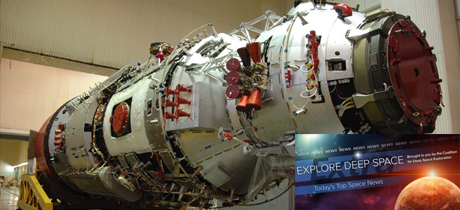In Today’s Deep Space Extra… Lunar ice could be a major resource for human deep space exploration. Researchers find potential latent health concern for human space exploration. Russia revives launch plans for International Space Station (ISS) science module. More White House 2020 budget proposal details expected Monday.
Human Space Exploration
New research module Nauka for ISS to undergo pre-flight tests – Roscosmos chief
TASS of Russia (3/17): The long delayed launch of Russia’s large Nauka science module to the International Space Station (ISS) could proceed in 2020, according to Dmitry Rogozin, head of Roscosmos, the Russian space agency. Recently, the Nauka’s delay promoted Russian to temporarily reduce the number of cosmonauts assigned to the Station from three to two.
Moon mining could actually work, with the right approach
Space.com (3/15): Lunar reconnaissance points to the presence of water ice, a resource supporting future economic development and human deep space exploration, in permanently shaded regions of the Moon and perhaps locked in the mineralogy of surface materials. With investments in lunar mining and power technologies, that resource could be processed into rocket propellants. Commercial Lunar Propellant Architecture: A Collaborative Study of Lunar Propellant Production, a recent report compiled by members of the aerospace industry, scientists and legal experts examines the opportunity.
Dormant viruses activate during spaceflight
Physics.org (3/15): The physical stresses of long spaceflights appear to suppress the immune systems of astronauts, allowing dormant viruses to appear in saliva and urine samples, according to research published in Frontiers of Microbiology. Usually, the virus shedding is not accompanied by actual symptoms, yet it represents a human exploration health concern.
Apollo 11: How millennials can grasp the greatest event ever for now
The Hill (3/15): The stirring documentary Apollo 11 may offer millennials a historical context for human space exploration, according to an op-ed that delves into why their enthusiasm is essential to a future space workforce.
Space Science
A NASA spacecraft may have explored the edges of an early Mars sea in 1997
Physics.org (3/15): A new study finds evidence that NASA’s first Martian rover, Pathfinder, landed in the spillway remnants of an ancient now dry sea bed. Studies so far indicate that Mars underwent a transition from warm and wet in its early epoch to the current cold, dry desert like conditions. The findings were reported in the journal Nature Scientific Reports.
Era of big NASA space telescopes may be ending
Space.com (3/16): Despite strong support within the astrophysics community, efforts by NASA to develop space telescope/observatory successors to the Hubble Space Telescope have encountered new challenges as funding shifts from science to efforts to transition human space exploration from low Earth orbit to deep space. Top line NASA spending will fall from $21.5 billion to $21 billion under the 2020 White House budget proposal presented to Congress last week, and the space science line would fall from $6.9 billion to $6.3 billion. For a second year in a row, the White House proposes cancellation of the Wide Field Infrared Space Telescope (WFIRST), an observatory planned for the mid-2020s. Congress prevented cancellation in 2019.
U.S. detects huge meteor explosion
BBC (3/18): A large fireball exploded over the Bering Sea in December. Traveling at high velocity it exploded at high altitude with the force of a nuclear bomb. NASA was notified of the event after the blast was detected by U.S. military satellites. Lindley Johnson, NASA’s planetary defense officer, explained the incident during a presentation Sunday at the annual Lunar Planetary and Science Conference. The agency’s Planetary Coordination Office, which marked its third anniversary earlier this year, is charged with detecting impact threats, spreading the world and preparing a response.
Other News
WGS-10 satellite launches atop ULA’s Delta IV rocket
Coalition Member in the News – United Launch Alliance
Spaceflightinsider.com (3/15): A U.S. Air Force WGS satellite for battlefield communications launched Friday night atop a United Launch Alliance (ULA) Delta IV rocket from Cape Canaveral Air Force Station, Florida.
Air Force sees upcoming Falcon Heavy launches as key to certifying reused rockets
Spaceflightnow.com (3/15): The upcoming second launch of a SpaceX Falcon Heavy with an Arabsat communications satellites may provide an important test of the company’s approach to reuse of launch hardware that could lead to certification for future U.S. national security missions.
Major Space Related Activities for the Week
Major space related activities for the week of March 17-23, 2019
Spacepolicyonline.com (3/17): More details from the White House budget proposal for 2020 are set to be released Monday. The American Astronautical Society hosts the annual Goddard Memorial Symposium with a focus on missions to the Moon, Mars and Beyond as well as U.S. National Security. The week long Lunar and Planetary Science Conference gets under way on Monday as well near Houston. On Friday, International Space Station (ISS) astronauts Anne McClain and Nick Hague, both of NASA, will team for the first of three upcoming spacewalks, the first focused on the installation of new lithium ion power storage batteries on the Station’s solar power truss. Future excursions are planned for March 29 and April 8. The second excursion will team McClain with NASA’s Christina Koch for the first all-woman spacewalk.

